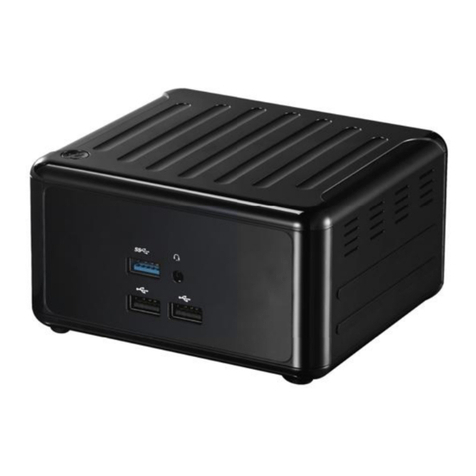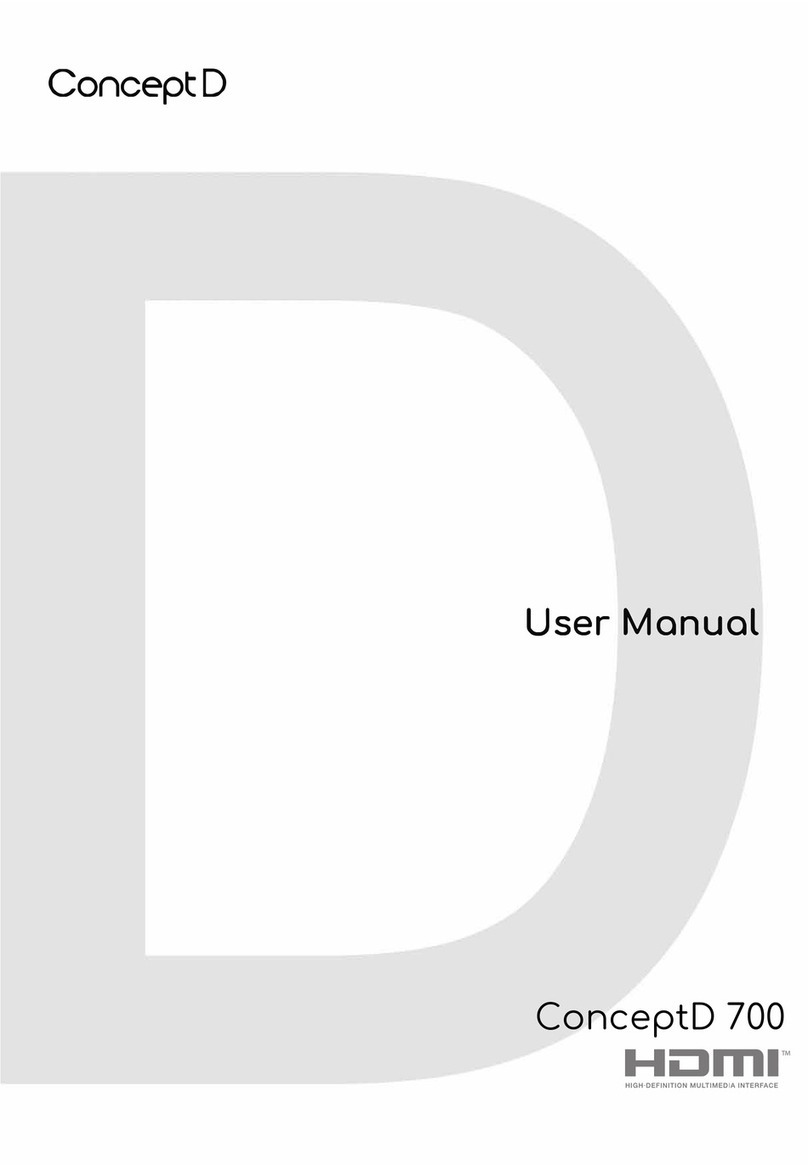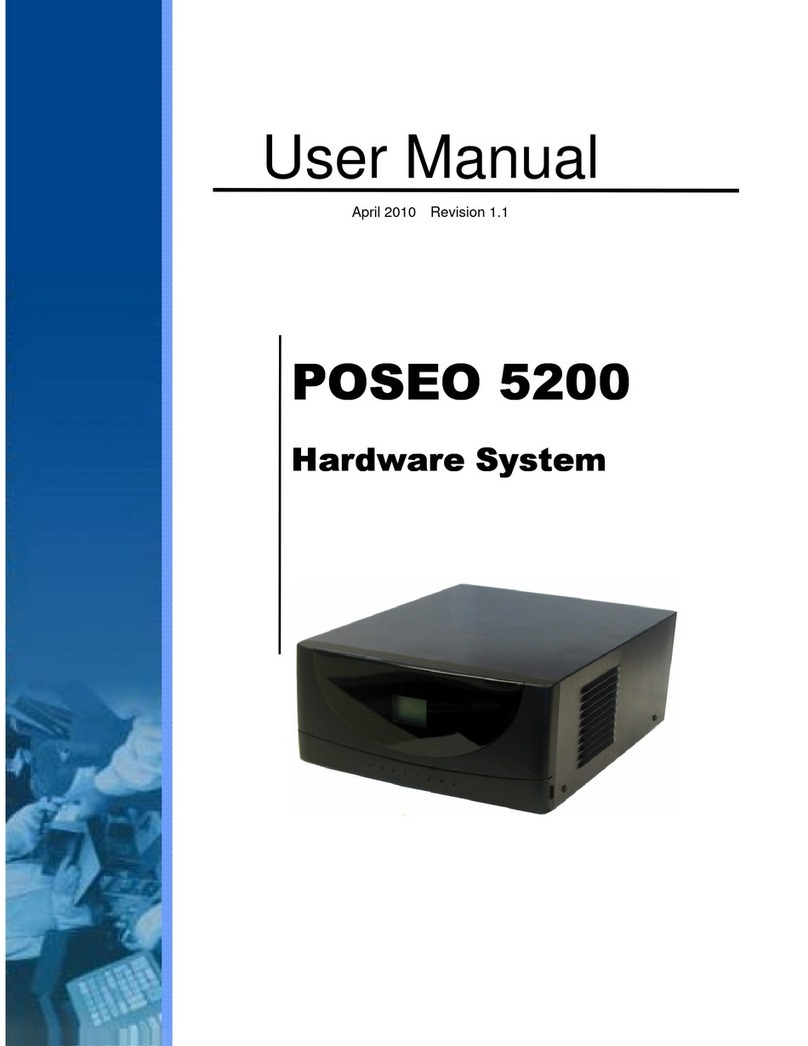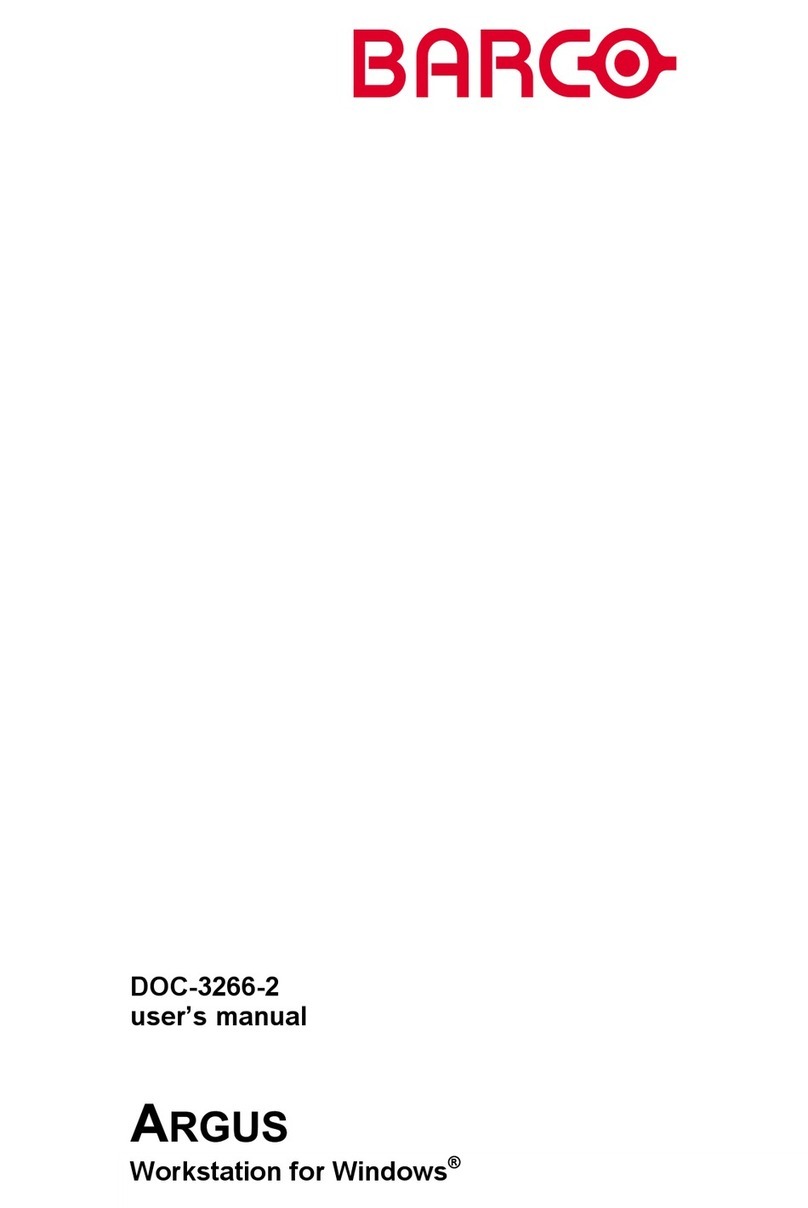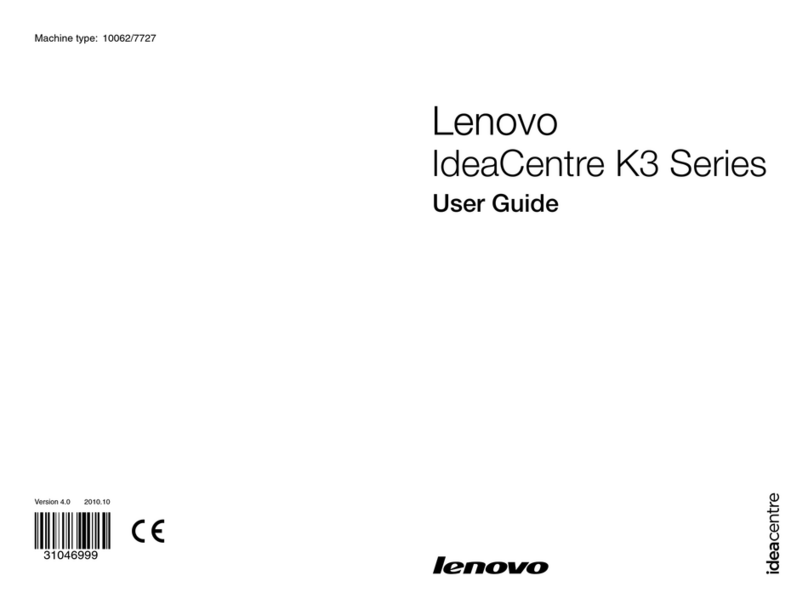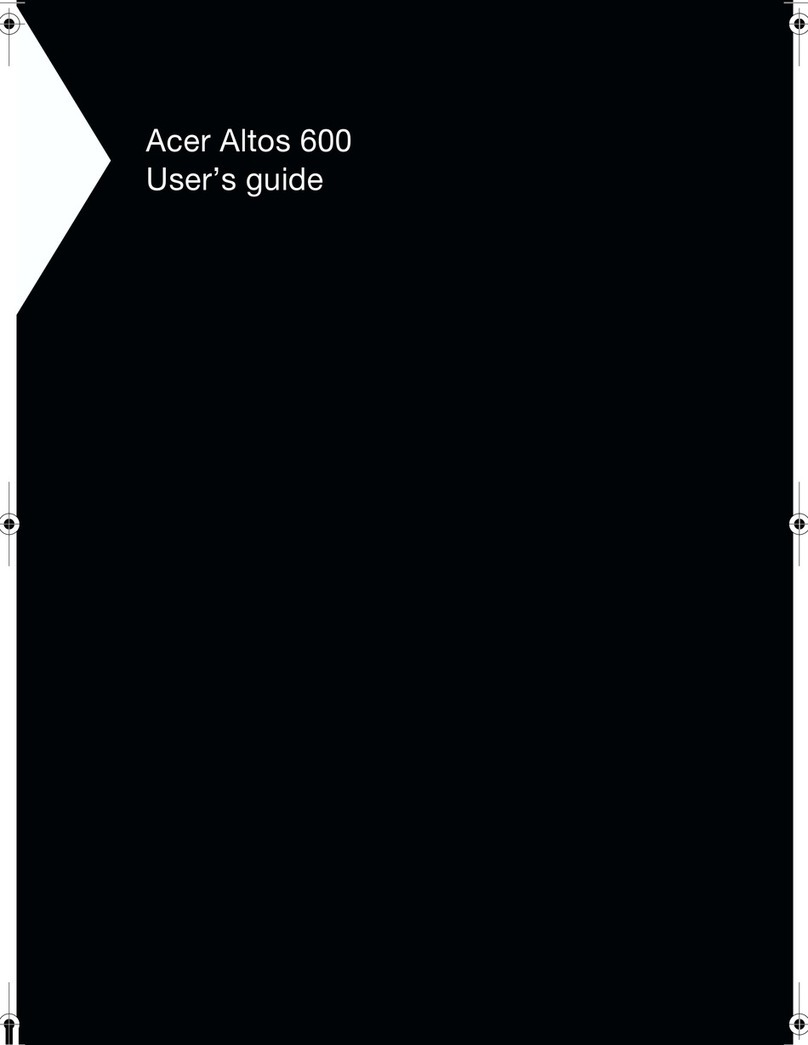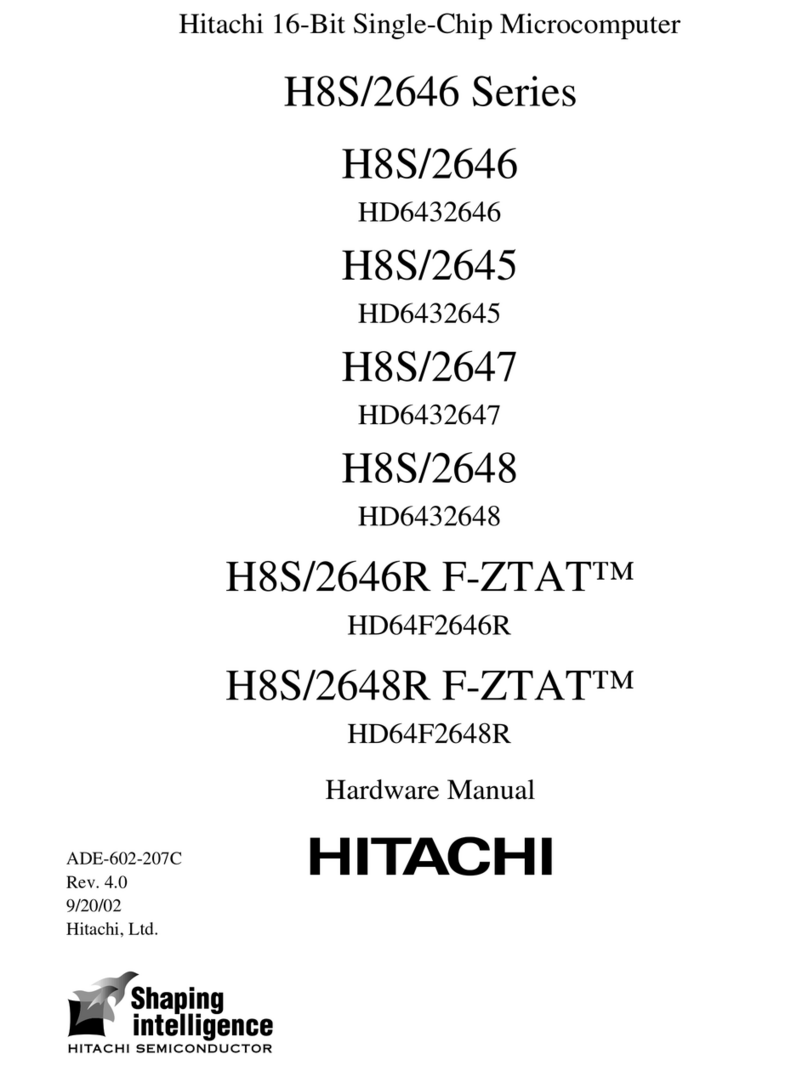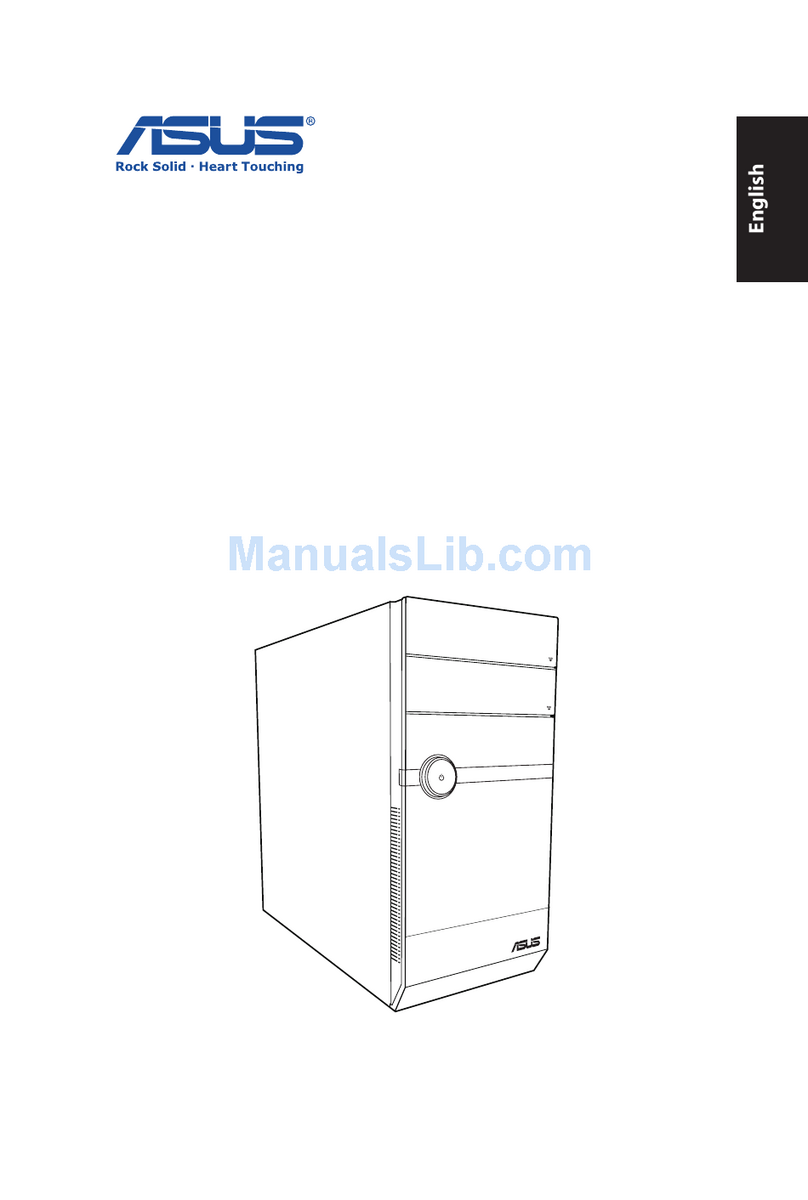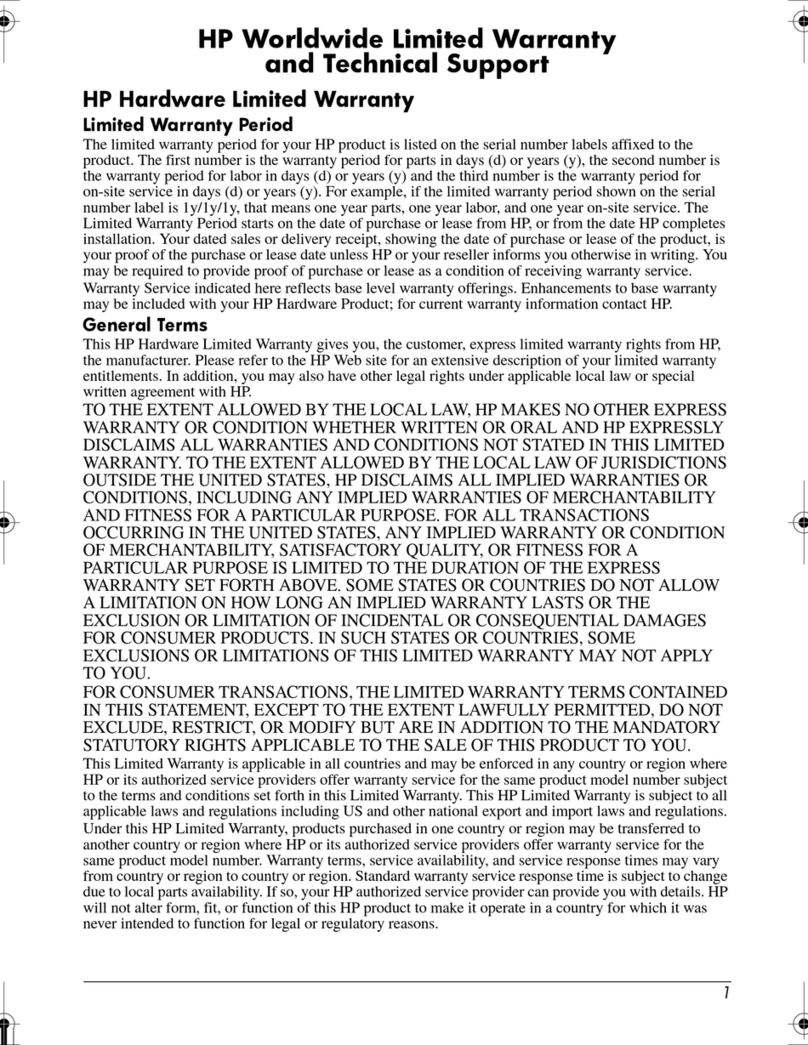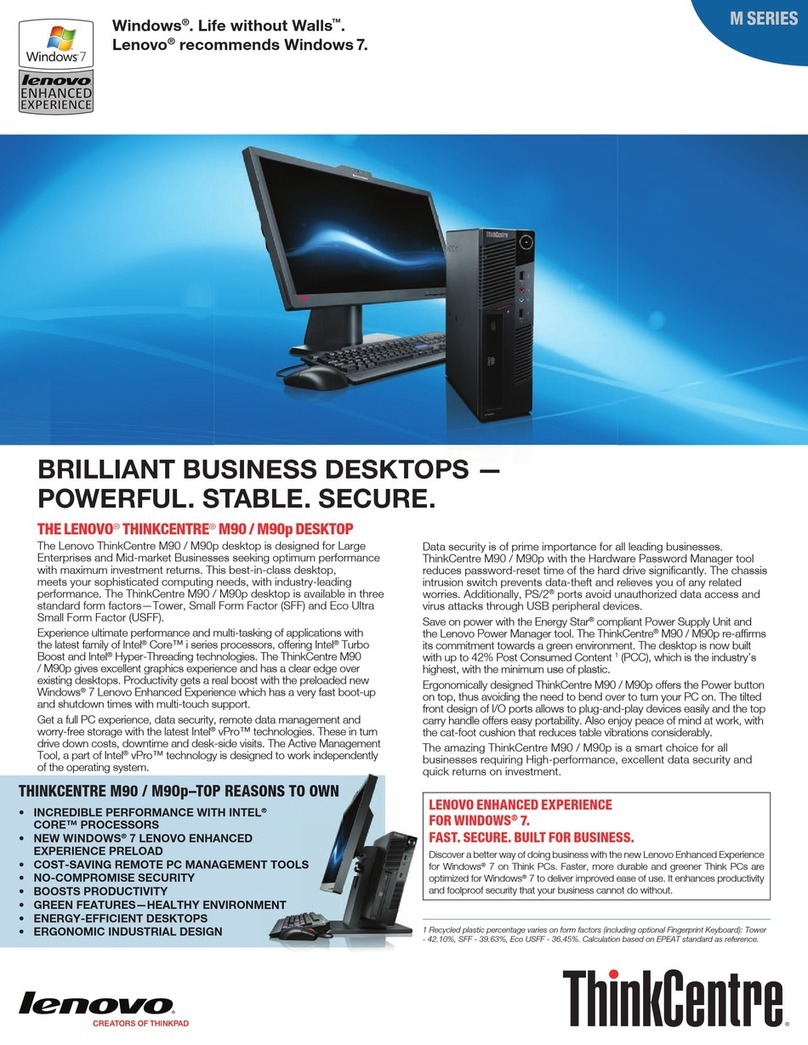Advanced Micro Computers Am96/4116A User manual

Advanced
Micro
Computers
Asubsidiary of
Advanced Micro Devices
Am96/4116A
AmZ8000
16-Bit
MonoBoard™
C~omputer
User's Manual
059910090-001
$10.00

REVISION RECORD
REVISION DESCRIPTION
01 Preliminary Issue
(8/28/81)
AManual Released
(10101/81)
-----
------
--
.-
Publication No.
059910090-001
Address comments concerning
this manual
to:
REVISION l.ETTERS
I,
0,
aAND xARE NOT USED
©
1981
Advanced Micro Computers
Printed
in
U.S.A.
ii
ADVANCED MICRO COMPUTERS
Publications Department
3340 Scott Boulevard
Santa Clara, CA
95051

PREIFACE
This
manual
provides general information,
an
installation
and
interface
guide,
programming
information,
principles
of
operation,
and
service
information
for
the
Advanced
Micro
Computers
Am96/4116A
MonoBoard
Computer.
Additional information concerning components of the
Am96/4116A
is
available
in the following documents:
•
AmZ8001/2
Processor
Instruction
Set
•Zilog,
Z80Dl
CPU/Z8002
CPU
Product Spec.
•
AMD
Shottky
and
Low
Power
Shottky
Data
Book
•
Am8251-Am9551
Data Sheet
•
Am8255A/Am8255A-5
Data Sheet
•
Am9513
Data
Sheet
•
Am9513
Application Brief
•
8259A
Data
Sheet
(Intel)
•Multibust
Interfacing
(Intel
Application
Note
AP-28J\)
In
this
manual, both active-high
(positive
true)
and
active-low
(negative
true)
signals
appear in the
text.
To
eliminate confusion
and
simplify
presentation,
the following convention
is
used throughout
this
manual·:
The
mnemon'ic
for
asignal
that
is
active-low
is
followed
by
an
asteri
sk
(i.
e.
MEM:R*)
•
The
mnemon
ic
for
an
act
ive-h i
gh
signal
is
denoted without the
asterisk
suffix.
Common
mnemonics
and
acronyms
are used without additional explanation.
The
fi
rst
time anon-standard or
uncommon
acronym
is
used,
its
full
name
wi
11
be
spe
1"1
ed
out
and
the
acronym
enclosed in parenthes
is.
Following references will use the
acronym
without
further
explanation.
The
information in
this
manual
is
believed
to
be
accurate
and
complete
at
the time
it
was
printed.
AMC
reserves the
right
to
change
specifications
without
notice.
No
responsibility
is
assumed
for
errors
that
might appear in
this
manual.
No
part of
this
manual
may
be
copied or reproduced in
any
form
without
prior
written
permission
from
AMC.
tMultibus' a
registered
trademark of
Intel
Corporation
iii/iv


TABLE OF
~CONTENTS
1.
GENERAL
INFORMATION
•••••••••••••
l-l
Introduction
••••••
~
•••••••••••••
I-1
Physical Description
••••••••••••
l-l
Functional Description
••••••••••
1-2
Specifications
••••
G
•••••••••••••
1-5
2.
INSTALLATION
AND
INTERFACE
••••••
2-1
Introduction
••••••
G
•••••••••••••
2-1
Unpacking
and
Inspection
••••••••
2-1
Power
Requirements~
•••••••••••••
2-1
Cooling Requirements
••••••••••••
2-1
User
Selectable
Options
•••••••••
2-2
Memory
Expansion
.....
'"
•••••••••
2-2
Starting
Address of
On-Board
RAM
••• o
•••••••••••••
2-3
Wait
State
for
Slow
ROMs
••••••
2-3
Serial
I/O
Peripheral
Interface
Clock
Select
•••••••
2-4
Baud
Rate Selecto •••
~
•••••••••
2-4
Customizing
Data
Set
Operation
••••••••••
~
•••••••••
2-4
Auxiliary Connector
P2
••••••••
2-5
Interrupt
Jumpers
•••
~
•••••••••
2-6
Parallel
I/O
Interface
••••••••
2-7
Enable Real-Time
Clock
••••••••
2-9
On-board
ROM
Type
Se'lection•••2-9
System
Bus
Priority.G
•••••••••
2-9
Initialize/Power
Up
Reset
•••••
2-9
Bus
Clock
(BCLK)
and
Constant
Clock
(CCLK)
Jumpers
••••••••••••
o
•••••••••
2-9
Dual
Port
RAM
Access ••
~
••••••••
2-10
Interface
Requirementso
••••••••
2-10
Bus
Interface
•••••••••
G
••••••••
2-10
DC
Bus
Characteristicso
••••••••
2-10
3.
OPERATION
AND
PROGRAMMING
•••••••
3-1
.Introduction
••••••••••
o
•••••••••
3-1
I/O
Address
AssignmentG
•••••••••
3-1
Shared
Memory
and
the
r1ul
t i
bus
••3-1
Block-Select
Memory
Expansion•••3-2
ROM
Addressing
••••••••
o
•••••••••
3-2
Serial
I/O
Interface
Programming
••••••••••
o
•••••••••
3-4
Am9551
Initialization
•••••••••
3-4
Am9551
Mode
Instruction
Word
Format
•••••••••••••••••••••••
3-5
Am9551
Sync
Characters
••••••••
3-5
Command
Instruction
Word
Format
••••••••
~
••••••••••••••
3-5
Am9551
Status
Read
••••••••••••
3-6
Parallel
I/O
Interface
Programming
••••••••••••••••••••
3-8
Am8255A
Addressing
••••••••••••
3-8
Am8255A
Initialization
••••••••
3-8
Am8255A
Operation Control
Word
Format
•••••••••••••••••
3-11
Am8255A
Bit Set/Reset Control
Word
••••••••••••••••••••••••
3-11
Interrupt
Control
Programming
•• 3-12
Initialization
•••••••••••••••
3-12
Operation Control
••••••••••••
3-14
System
Timing
Controller
Programming
•••••••••••••••••••
3-17
Command
Register
•••••••••••••
3-17
Status
Register
••••••••••••••
3-18
Master
Mode
Register
•••••••••
3-19
Time
of
Day
••••••••••••••••••
3-20
Comparator Enable
••••••••••••
3-21
FOUT
Source
••••••••••••••••••
3-22
FOUr
Divider
•••••••••••••••••
3-22
FOUT
Gate
••••••••••••••••••••
3-22
Bus
Width
••••••••••••••••••••
3-22
Data
Pointer
Sequencing
••••••
3-22
Scaler
Ratios
••••••••••••••••
3-23
Frequency Scaling Counter
••••
3-23
FOUr
Divider Counter
•••••••••
3-24
Data Pointer Counter
•••••••••
3-24
Prefetch Latch
•••••••••••••••
3-25
Counter Logic
Groups
•••••••••
3-26
Counter
Load
Register
••••••••
3-26
Counter
Hold
Register
••••••••
3-27
Counter
Mode
Register
••••••••
3-27
Output Control
•••••••••••••••
3-28
Count
Control
••••••••••••••••
3-29
Count
Source Selection
•••••••
3-30
Gating Control
•••••••••••••••
3-31
Alarm
Registers
and
Comparators
•••••••••••••••••
3-31
Output Control Bit
•••••••••••
3-32
Baud
Rate
Programming
••••••••••
3-32
v

4.
THEORY
OF
OPERATION
•••••••••••••
4-1
Introduction
••••••••••••••••••••
4-1
Central Processing Unit
(CPU)
•••
4-1
Random
Access
Memory
••••••••••
4-5
ROM/EPROM
•••••••••••••••••••••••
4-5
Memory
Expansion
••••••••••••••••
4-5
Serial
I/O
Interface
••••••••••••
4-6
Parallel
I/O
Interface
••••••••••
4-8
Interrupt
Controller
••••••••••••
4-9
System
Timing
Controller
•••••••
4-10
5.
SERVICE
INFORMATION
•••••••••••••
5-1
Introduction
••••••••••••••••••••
5-1
Service
and
Repair Assistance•••
5-1
Service
Diagrams
••••••••••••••••
5-1
FIGURES
1-1.
Am96/4116A
MonoBoard
Computer,
Block
Diagram
•••••••••••••••
1-3
2-1.
Off-Boa
rd
Memory
Expans
i
on
Using
Normal/System
and
Code/Data Signals
•••••••••••
2-3
2-2.
Parallel
I/O
Line
Terminator
••••••••••••••••••
2-7
3-1.
Am96/4116A
to
Multibus
Interface
•••••••••••••••••••
3-3
3-2.
Memory
Expansion
•••••••••••••
3-3
3-3.
Am9551
Synchronous
Mode
Control
Code
••••••••••••••••
3-6
3-4.
Am9551
Asynchronous
Mode
Control
Code
••••••••••••••••
3-6
3-5.
Am9551
Command
Instruction
Word
Format
•••••••••••••••••
3-7
3-6.
Am9551
Status
Word
Format
••••
3-8
3-7.
Am8255A
Operation Control
Word
Format
••••••••••••••••
3-11
3-8. Bit Set/Reset Control
Word
Format
•••••••••••••••••••••
3-12
3-9.
Initialization
Control
Word
(ICW)
Formats
••••••••••••••
3-13
3-10. Operation Control
Word
(OCW)
Formats
••••••••••••••
3-15
3-11. Rotating
Priority
Mode
A
(Automatic Rotation)
•••••••
3-16
3-12. Status Register Bits
••••••••
3-18
3-13. Master
Mode
Register Bits•••3-20
3-14. Time-of-Day Configurationo •• 3-21
3-15. Frequency Scaler Ratios
•••••
3-23
3-16. Data Pointer Counter
••••••••
3-24
vi
3-17. Counter
Mode
Register Bit
Assignments
••••••••••••••••
3-28
3-18.
TC
Waveform
Format
••••••••••
3-29
4-1.
Am96/4116A
MonoBoard
Computer,
Block
Diagram
•••••
4-2
4-2.
CPU
Memory
Operations
••••••••
4-4
4-3. Processor-to-Processor
Transfer via
Memory
•••••••••
4-5
5-1.
Am96/4116A
MonoBoard
Computer,
Component
Locations
•••••••••••••••••••
5-2
5-2.
Am96/4116A
MonoBoard
Computer, Schematic
Di
agram
•••••••••••••••••••••
5-3
5-3.
Am96/4116A
MonoBoard
Computer, Schematic
Diagram
•••••••••••••••••••••
5-4
5-4.
Am96/4116A
MonoBoard
Computer, Schematic
Diagram
•••••••••••••••••••••
5-5
5-5.
Am96/4116A
MonoBoard
Computer, Schematic
Diagram
•••••••••••••••••••••
5-6
5-6.
Am96/4116A
MonoBoard
Computer, Schematic
Diagram
•••••••••••••••••••••
5-7
5-7.
Am96/4116A
MonoBoard
Computer, Schematic
Di
ag
ram
•••••••••••••••••••••
5-8
5-8.
Am96/4116A
MonoBoard
Computer, Schematic
Diagram
•••••••••••••••••••••
5-9
5-9.
Am96/4116A
MonoBoard
Computer, Schematic
Diagram
••••••••••••••••••••
5-10
5-10.
Am96/4116A
MonoBoard
Computer, Schematic
Diagram
••••••••••••••••••••
5-11
5-11.
Am96/4116A
MonoBoard
Computer, Schematic
Diagram
••••••••••••••••••••
5-12
5-12.
Am96/4116A
MonoBoard
Computer, Schematic
Diagram
•••••••••
o
••••••••••
5-13
5-13.
Am96/4116A
MonoBoard
Computer, Schematic
Diagram
••••••••••••••••••••
5-14

TABLES
1-1.
Specifications
•••••••••••••••
1-5
2-1. Address Paging Jumpers
•••••••
2-2
2-2.
Serial
I/O
Jumpers
•••••••••••
2-4
2-3. ConneGtor
P4
and
P5
to
Terminal Connector Pin
Assignments
•••••••••••••••••
2-5
2-4.
P2
Connections
•••••••••••••••
2-5
2-5.
Non-Maskable
Interrupts
••••••
2-6
2-6.
Priority
Interrupt
Jumpers •••2-6
2-7.
Parallel
I/O
Port A
and
B
Jumpers
•••••••••••••••••••••
2-7
2-8.
Parallel
I/O
Socket
Compatible Line Drivers
•••••
2-8
2-9.
2-10.
2-10.
2-11.
2-12.
3-1.
3-2.
3-3.
3-4.
3-5.
Parallel
I/O
Connector
P3
•••••
2-8
ROM
Type
Jumper
Selection
•••••
2-9
Am96/4116A
Connectors
•••••••••
2-10
System
Bus
Connector
PI
Pin Assignments
•••••••••••••
2-11
Am96/4116A
Bus
DC
Characteristics
•••••••••••••
2-12
I/O
Port Address
••••••••••••••
3-2
Parallel
I/O
Port
Configuration
Summary
••••••••
3-9
Control Element
Summary
••••••
3-17
Command
Summary
••••••••••••••
3-19
Baud
Rate Selection
••••••••••
3-32
vii


CHAF)TER 1
GENERAL INFORMATION
INTRODUCTION
The
Am96/4116A
MonoBoard
Computer
(MBC)
is
acomplete,
AmZ8002
based,
16-bit,
microcomputer
on
a
single
board.
It
is
plug compatible with
the
Intel
Multibus board product
interface.
The
Am96/4116A
offers
the
following
features:
•
High
performance,
AmZ8002,
16-bit
microprocessor.
•Supports
up
to
ei
ght
ki
1obytes
of
on-board
RO~1.
Two
sockets
are
provided with jumper
selectable
addressing
for
2K,
4K,
or
8K
bytes.
•
Under
software
control,
addresses
for
on-board
shadow
RO~1
are
mapped
to
off-board
RAM.
•Supports
up
to
32
k
i"\
obytes of on-board
dynami
cRAM.
•Two-port confl!
gurat
i
on
of
RAM.
RAM
can
be
si
mul
taneous1y
accessed
by
the
AmZ8000
and
the
Multibus.
If
both
are
attempting
continuous
access,
50%
interleave
results.
•Eight fully-programmable,
vectored,
priority
interrupt
channels
wi
th
provi sions
for
software generated
interrupts.
24
source
s.
•
Two
Ser;a1
Communi
cat
ions
Interfaces,
one
wi
th
full
RS232C
support
and
the
other
with modified
RS232C
support.
• A
parallel
I/O
interface
with
two
8-bit
ports
and
two
4-bit
ports
socketed
for
drivers
or
receivers.
•Programmable Timer
for
on-board
time-of-day
clock
and
delayed
interrupts.
PHYSICAL
DESCFIIPTION
The
Am96/4116A
MonoBoard
Computer
(MBC)
is
a
four-layer
printed
circuit
board with
MSI
TTL
and
LSI
MOS
circuits.
Five edge connectors provide
bus
and
peripheral
interface
capabilities.
Physical
characteristics
of
the
Am96/4116A
are:
1-1

Board
Dimensions:
Width
Depth
Thickness
30.48
cm
(12.00 inches)
17.15
cm
(6.75 inches)
1.50
cm
(0.60 inches)
Environmental Requirements:
Operating Temperature
O°C
to
55°C
Relative Humidity
Up
to
90%
without condensation
Storage Temperature
-40°C
to
+75°C
FUNCTIONAL DESCRIPTION
The
Arn96/4116A
'MonoBoard
Computer
contai
ns
an
ArnZ8002
CPU,
two
Arn9551
serial
ports,
one
Am8255A
parallel
I/O
port,
an
Am9513
timer,
an
8259A
interrupt
contro
11
er,
32
k
il
ob.ytes of
RAM,
two
sockets for
2K,
4K,
or
8K
of
ROM,
and
various
TTL
circuits.
The
board
is
compatible with the
Multibus
interface
requirements.
The
ArnZ8002
CPU
is
an
advanced
architecture,
16-bit
microprocessor with
an
instruction
set
more
powerful than
many
minicomputers. There are
sufficient
resources,
such
as
sixteen
16-bit
general purpose
registers,
seven data types,
eight
addressing
modes,
and
110
distinct
instruction
types.
The
110
distinct
instructions
can
be
combined
with the various data types
and
addressing
modes
to
expand
the
instruction
set
to
414
instructions.
Most
instructions
can
use
any
of the
five
addressing
modes
and
can
operate
on
byte
(8-bit),
word
(16-bit),
and
long-word (32-bit) data, types.
Figure 1-1
is
ablock diagram of the
Am96/4116A.
Selection of
ROM
is
optional.
Two
sockets are provided to
accommodate
ROM"
The
ROM
type
can
be
Arn2708
or
Arn2758
(2
ki1
obytes),
Arn2716
or
Am9218
(4
kilobytes),
or
Arn2732
or
Am9233
(8
kilobytes).
Jumpers
are
provided to
select
the
correct
ROM
addressing
scheme
to
accommodate
the
various
ROMs.
Addresses
for
the
Am2708
range
from
0through
07FFH;
the
Am2716
addresses range
from
0through
OFFFH;
and
the
Arn2732
addresses
range
from
0through
1FFFH.
The
ROM
addressing range
is
8,192
bytes.
If
2kilobyte
or
4kilobyte
ROM
is
impl
emented, the
unused
address space,
from
0800
to
1FFFH
or
1000
to
1FFFH,
for
2kilobyte
or
4kilobyte
ROM,
respectively,
will
be
mapped
to off-board
RAM.
A'll
ROM
on
the
Arn96/4116A
MonoBoard
Computer
is
Shadow
ROM.
AWrite
instruction
addressed
to
port
FFFOH
disables on-board
ROM
and
causes
memory
access to addresses 0through
1FFFH
to
be
mapped
to
off-board.
Either
ROM
or
RAM
can
be
used
as
off-board
memory;
both read
and
write
operations
at
the off-board
memory
are allowed,
even
though a
wri
te
operation
when
ROM
is
used
is
meaningless. AWrite
instruction
addressed
to
port
FFF1H
enables the on-board
ROM.
When
first
powered-up,
ROM
is
enabled.
Shadow
ROM
and
RAM
can
occupy
the
same
1-2

P3
P4
P5
+.
+.
+. +.
II
BIDIRECTIONAL IBIDIRECTIONAL DRIVER ANDlOR RS232C RS232C
BUFFER BUFFER TERMINATION INTERFACE INTERFACE
i
f8
844I
PA0-7
PBO-7
PC0-3 PC4-7
Am9S55A Am9551
Am9S51
PARALLEL
110
SERIAL
110
SERIAL
110
CLOCK
I--
t
,v
8t
,v
8I
...
""
816-BIT
16 16 ADDRESS
•
r-f-
ADDRESS
~
ADDRESS
RESET BUFFER ,BUFFER
t----
CIRCUITS
r--
I I
MULTI-
AmZ8002 MASTER
CONTROL
t16-BIT
16
DATA DATA DATA
~
~
BUFFER
f16
+
16
+16
f8
BUFFER
RAM 32K ROM Am9513 8259A
BYTES SYSTEM TIMING INTERRUPT
DUAL-ACCESS
21418
KBYTES CONTROLLER CONTROLLER
f8
I
.....
I
INTERRUPT
JUMPER PINS
P2
P1
Figure 1-1.
Am96/4116A
MonoBoard
Computer,
Block
Diagram

physical address space.
It
is
possible
to
write to
RAM,
but
RAM
can
only
be
accessed
for
read
when
the
shadow
ROM
is
disabled.
This
permi
ts
all
or portions of
ROM
to
be
copi
ed
to
RAM
and
then the
ROM
turned
off.
There are
32K
bytes of
dynamic
RAM
included
on
the
Am96/4116
board,
configured as two-port (dual access)
memory.
Sixteen 16,384
by
1,
N-channel
dynamic
R/W
RAMs
are used.
With
200
nanosecond
RAMs,
no
watt
state
is
needed.
RAM
can
be
simultaneously accessed
from
the Multibus
interface
and
the
AmZ8002
CPU.
Access
arbi
trat
i
on
for
two-port operati
on
provides
50
percent
interleave
of
ArnZ8002
and
Multibus access. Control
defaults
to
the
AmZ8002
if
no
Multibus requests are
active.
An
8259A
provides
an
eight
channel vectored
priority
interrupt
system.
The
eight channels
can
be
programmed
to perform
priority
resolution
on
either
afixed or
rotating
basis in
either
an
interrupt
or polled
mode,
allowing the user
flexibility
to
establish
interrupt
service
priorities
based
upon
individual requirements.
The
eight inputs
to
the
8259A
are jumper
selectable
from
an
interrupt
matrix. Selection
can
be
from
eight
gated Multibus
interrupts,
four
serial
port
(Am9551)
interrupts,
one
parallel
port
(Am8255A)
interrupt,
and
interrupts
from
the timer chip
(Am9513).
Non-maskable
interrupts
are also produced
and
are,
Multibus
power
fail,
timeout
for
AmZ8002
access to Multibus, selected
interrupt
from
interrupt
matrix,
and
odd
word
trap.
The
system contains
one
Arn8255A
Programmable
Peripheral
Interface
containing
three
parallel
I/O
ports.
Two
8-bit
ports are buffered with
bidirectional
buffers.
The
buffer
direction
for
each port
is
selected
by
jumper to provide
either
input,
output or
dynamic
direction
control
using a
bit
from
one
of the
two
4-bit
ports.
The
remaining port
on
the
Am8255A
is
configured as
two
4-bit
ports socketed
for
drivers
or
receivers
(optional).
Signals
from
each
4-bit
port are
used
as
interrupt
signals
at
the
interrupt
matri x.
The
I/O
1i
nes
are brought
out
at
the
50
pin connector
P3
at
the top of the board.
Two
Am9551
Programr.1able
Communications
Interfaces
provide
two
serial
I/O
ports.
One
of these ports supports a
full
RS232C
interface.
The
other
supports amodified
RS232C
interface
where,
Data
Set Ready,
and
Clear
to
Send
signals
ar'e
omitted.
The
Am9551
provides
full
duplex,
buffered transmi t
and
recei
ve
capabi 1
it
i
es.
A
programmable
baud
rate
generator provides
baud
rates
between
50
and
9
,600
baud
for
asynchronous data transmission,
and
up
to 38,400
baud
for
synchronous
operation.
Each
communications
interface
can
be
programmed
to
implement the desired synchronous or asynchronous
serial
data protocol.
Data
format, control
character
format,
and
pari
ty
are under
program
control.
Parity,
overrun,
and
framing
error
detection are
all
incorporated
on
the
programmable
communications
interface.
Command
and
control
lines,
serial
data
lines,
and
signal
ground
lines
are brought
out
to
P4
and
P5
at
the top the board.
1-4

The
system
includes
an
Am9513
System Timing
Controller
to
enhance
system
capability
with
respect
to
counting
and
timing
operations.
It
provides
the
capability
for
programmable frequency
synthesis,
complex
waveform
generation
including
programmable duty
cycles,
digital
one-shots,
time-of-day
clocking
including
alarms,
pulse
generation,
baud
rate
generat
ion" frequency shi
ft
keyi ng,
stop
watch t
imi
ng, event
count accumulation,
and
many
more
applications.
The
Am9513
can
be
dynamically
reconfigured
under program
control.
Source,
gate,
and
output
1ines
are
brought out
to
connector
P2
at
the
bottom
of
the
board.
SPECIFICATIONS
Specifications
for
the
Am96/4116
MonoBoard
Computer
are
listed
in
table
1-1.
TABLE
1-1.
SPECIFICATIONS
Word
Size
I
nstruct
I
on:
Data:
1
word
(16
bits)
to
4
words
(64
bits)
byte
(8
bits),
word
(16
bits),
or
long
word
(32
bl
ts)
Memory
Addressing
On-board
ROM/EPRa.1:
Q-7FFH
(2708
chips)
O-OFFFH
(2716
chips)
0-1
FFFH
(2732
ch
Ips)
On-
board
RAM:
Of
f-
boa
rd
Memory:
800o-FFFFH
or
000Q-7FFFH
0000-7FFFH
or
8000-FFFA-f
Any 32K
space
not
occupied
by
on-board
RAM.
Memory
Capacity
On-
board
ROM/EPRa.1:
2
sockets
for
up
to
8K
bytes
2708
E-PRa.1
or
2758
ROM
2716
E-PROM
or
9218 Mask
ROM
2732
E-PROM
or
9233
Mask
ROM
2K
bytes
4K
bytes
8K
bytes
On-
board
RAM:
Dynaml
c,
32K
bytes
1-5

TABLE
1-1.
SPECIFICATIONS
(continued)
Shadow
ROM
A
Wr
Ite
canmand
to
I/O
port
FFFOH
dI
sab
les
address
I
ng
on-board
Rav1
and
causes
ROM
ad-
dresses
0
to
8K
to
be
mapped
to
of
f-
board
RAM.
AWrite
to
I/O
port
FFF1
enables
on-
board
RQ\1.
RAM
Access Type of Access:
2-port
(Dual Access)
Walt
States:
No
wait
states
for
access
from
Aml8002
Access Time from 1350-3275 nanoseconds
Multlbus,
Command
to
XACK
Time:
w/2
port
RAM
lock:
First
Access:
Subsequent
Access:
1350-3275
ns
737-1087 ns
Multlbus
Interface
Clocks:
BCLK
and
CCLK
jumperable
Exchange
Capability:
Serial
priority
on-board
Paral
lei
pr
lorlty
off-board
Bus Lock:
Wr
Ite
to
I/O
port
FFF9H
locks
the
bus
to
exclude
other
access.
Write
to
I/O
port
FFF8H
un
locks
the
bus.
Multibus
Interrupts:
Non-bus
vectored
Interrupts
are
supported
and
may
be
Implemented
with
the
following
options:
Interrupts
are
always
jumpered.
recognized
when
J.L9
Port
Functions
Single
Step
Enable:
Bus
vectored
Interrupts
are
not
supported.
FFCOH
1-6
Interrupt
Contro
II
er
Data:
FFC8H
Control:
FFCAH
(Am8259A)
:
Timer (Am9513):
Data:
FFDOH
Control:
FFD2H
Serl"al I/O
Port
#1
Data:
FFD8H
Control
::
FFDAH
(Am9551
):
Serial
I/O
Port
#2
Data:
FFEOH
Control:
FFE2H
(Am9551):'
----_
..
-
..

TABLE
1-1.
SPECIFICATIONS
(continued)
I/O
Pc~t
Functions
Pa
r aI Ia I I
/0
(Am8;255A) :
RO'1
Enable:
RO'1
Di sab
Ie:
Multlbu5
Lock:
Multlbus
Unlock:
Port
Chan A:
Chan
B:
Shad~
On:
Shad
C1N
Of f :
FFE8H
FFEAH
FFF1H
FFFOH
FFF9H
FFF8H
Chan
C:
Control:
FFECH
FFEEH
Serial
I/O
Capacl!y'
Synchronous:
As
yn
chron
ous:
Baud
Rate:
5
to
8
bl
t
characters
I
nterna
I
or
external
syn
chron
I
zatl
on
Automatic
sync
Insertion
5
to
8
bi
t
characters
Break
character
generation
1,
1
1/2,
or
2
stop
bits
False
start
bit
detector
Programmab
Ie
Power
Requirements
En
vi
ronmenta
I
Characteristics
Paral
lei
Ity:
+
5V
DC
+12V
DC
-12V
DC
I/O
Capac-
Two 8
bl
t
ports
(A and B)
Two 4
bl
t
ports
(C
even and Codd)
socketed
for
drivers
or
receivers
Typical
(With
E-PROM
devices
Instal
lad)
3.80A
0.10A
0.03A
0°
to
55°C up
to
90%
without
condensation
Physl~
Length:
304.80
mm
<12.00
Inches)
Character
I
st
Ics
He
I
gth:
171.50
mm
(
6.57
Inches)
Thickness:
12.70
mm
(
0.50
Inches)
We
I
ght:
0.45
Kg
(
1.00
pounds)
Sh
Ipp Ing
We
I
ght:
1.36
Kg (
3.00
pounds)
1-7


CHAp·TER 2
IN~)TALLATION
AND INTERFACE
INTRODUCTION
This
chapter
pY'ovides
information
to
install
an
Arn96/4116A
MonoBoard
Computer
(MBC)
in
a
user1ssystem.
The
information
includes
unpacking
and
inspection,
and
user' design
information
such as
interface
data,
power
requirements,
cooling
requirements,
bus
interface
characteristics,
and
connector
pin
assignments.
UNPACKING
ANCt
INSPECTION
Inspect
the
shipping
carton
immed~iately
upon
receipt
for
evidence
of
mishandling during
transit.
If
the
shipping
carton
is
severly
damaged
or
water st'ai
ned,
Irequest
the
carri
er'
sagent
to
be
present
\\/hen
the
carton
is
opened.
If
the
carri
er'
sagent
is
not
present
when
the
carton
is
opened
and
the
contents
of
the
carton
are
damaged, keep
the
carton
and
packing
material
for
the
agent's
inspection.
Shipping
damages should
be
immediately
reported
to
the
carrier.
NOTE
Do
not
attempt
to
service
the
board
yourself
as
this
will
void
the
warranty.
It
is
suggested
that
salvageable
shipping
cartons
and
packing
~atcrials
be
saved
for
use
in
case
the
product must
be
shipped
in
the
future.
POWER
REQUIRE~MENTS
The
Arn96/4116A
requires
+5
Vdc
and
±12
Vdc
power
inputs.
The
power
supply must
be
capable
of
supplying
at
least
3.8A
to
accommodate
the
Am96/4116A
requirements.
COOLING
REQUIIREMENTS
The
Am96/4116
di SS"j
pates
approximately
30
~1
(typical).
Adequate
air
circulation
must
be
provided
to
prevent
a
temperature
rise
above
55°C
(131°F).
2-1

USER SELECTABLE OPTIONS
The
Am96/4116A
is
designed
as
ageneral purpose
16
bit
micro computer;
opti
ona
1j
umperi
ng
fac i1i
ty
is
prov
i
ded
to
ta
i1or board operati
on
to
specific
use.
Jumpers
must
be
in the
correct
positions
prior
to
bOard
operation.
The
following paragraphs provide
instructions
for
optional
jumper configurations.
MEMORY
EXPANSION
The
Am96/4116A
has
the
capability
of
bank
selecting
up
to sixteen
32k
byte blocks of off-board
memory,
for a
maximum
of
152k
bytes of
external
RAM
and/or
ROM.
Parallel
I/O
port C
bits
0
to
3,
are
used
to
select
the off-board
memory.
However,
off-board
memory
must
not
occupy
the
same
logical address space
as
the on-board
RAM.
If
on-board
RAM
is
in the upper
32k
(8000
to
FFFF
hex), then off-board
memory
must
occupy
the space
from
0000
to
7FFF
hex. Table 2-1
lists
the jumpers
available.
TABLE
2-1.
MEMORY
EXPANSION
JUMPERS
SIGNAL
JUMPER
PIN
(s)
PCO*
10
PCl*
12
PC2*
14
PC4*
16
ADRF*
62-63
ADI0*
65, 36-37
ADll*
68, 38-39
ADI2*
58, 40-41
ADI3*
59,42-43
N/S*
66
I-FETCH*
69
For
exampl
e,
to connect
PCO*
to the
Mul
ti
bus
ADI0*
pi
n, connect a
jumper
from
pin
10
to
65,
and
ajumper
from
36
to
37.
To
connect
PCl*
to
ADll*, connect ajumper
from
12
to
68
and
another
from
38
to
39.
Two
addi
tiona
1 1i
nes,
defi
ned
by
the
CPU,
are a
va
i1
ab
1e
at
jumper
pi
ns
.
to
expand
the
memory
to a
maximum
of
160K
bytes.
The
signals
are
I-FETCH*
(code)
and
N/S*
(Normal/System).
The
I-FETCH*
signal provides
the
capability
of having
two
separate areas of
memory
one
for
code
and
one
for
data.
The
N/S*signal
provides
for
two
additional areas of
memory,
one
for
system
use
and
one
for
normal
(user)
functions.
The
functions of
I-FETCH*
and
N/S*
can
be
combined
as
shown
in
figure
2-1.
The
blocks
shown
in figure 2-1 can
occupy
the
same
logical area of
memory,
though the physical
locations
will
be
different.
2-2

.------------,--------------------------,
U
':~2K
Normal
Code
32K
Normal
Data
32K
Normal
Code
32K
System
Data
System/Normal
and
Code/Data Lines
32K
Normal
Code
Data
32K
System
Code
Data
System/Nolrma
1Lines
B
32K
Norma
1
System
Code
32K
Normal
System
Data
Code/Data Lines
C
Figure 2-1. Off-Board
Memory
Expansion
Using
Normal/System
and
Code/Data Signals
STARTING
ADDRI:SS
OF
ON-BOARD
RAM
On-board
RAM
can
be
located in ei
ther
the upper or lower
32K
of
the
Am96/4116
memory
space.
For
the upper
32K
byte space, connect ajumper
between
pi
n
192
and
193.
To
locate
RAM
in the lower
32K
byte area
reconnect the jumper between
pi
n
192
and
193.
To
locate
RAM
in the
lower
32K
byte area reconnect the jumper between pins
193
and
194.
WAIT
STATE
FOI~
SLOW
ROM!;
One
wait
state
is
l"equired
for
Rm1s
with cycle time slower than
400
nanoseconds.
Instaillation
of jumper
186
to
187
introduces the wait
state.
2-3

SERIAL
1/0
PERIPHERAL INTERFACE CLOCK SELECT
The
Recei
ve
Clock
(RxC)
and
Transmi
t
Clock
(TxC)
for
the
two
Am9551
serial
I/O
devices are jumper
selectable.
The
clock inputs
for
serial
port 1can
be
jumpered
together
to
the on-board clock source, or
separately connected to external
RxC
and
TxC.
The
clock source
for
serial
port 2
is
on-board onlye Table 2-2
lists
the jumper
locations.
TABLE
2-2e
SERIAL
I/O
JUMPERS
SIGNAL
FUNCTION
JUMPER
I/O
CONNECTIONS
RxC-1
Ext"
Rcv
Clk
#1
147-161
P4-22
TxC-1
Ext"
Xmit
Clk
111
146-160
P4-14
RTS-1
Request to
Send
#1
132-134 (Active)
P4-9
130A-134
(Ground)
None
CTS-1
Clear
to
Send
#1
133-135 (Active)
P4-7
131-133
(Ground)
None
CTS-2
Clear
to
Send
#2
180-181
(Active)
P5-7
181-179
(Ground)
None
CLK-1
Baud
Rate
Clk
#1
141-143
(9600
Baud)
None
142-143 (Prog.)
None
CLK-2
Baud
Rate
Clk
#2
39-140
(9600
Baud)
None
138-139 (Prog.)
None
P4
is
Serial
Port #1.
P5
is
Serial
Port #2, (Modified
RS232C)
BAUD RATE
SELECT
The
Am96/4116A
baud
rate
is
programmable
us
i
ng
two
of the counters in
the
Am9513
System
Timing
Controller.
As
shipped
from
the
factory,
the
baud
rate
is
set
at
9600. Table 2-2
lists
the clock source jumpers.
Tab
1e3-5 1i
sts
the
va
1
ues
for
programmi
ng
other
baud
rates,
us
i
ng
asynchronous communications
mode.
CUSTOMIZING DATA
SET
OPERATION
The
Cl
ear
to
Send
and
Request
to
Send
signa1
s,
between
adata
set
or
data terminal
can
be
jumpered
to
external
signals
or
can
be
jumpered
to
ground
(to
be
continuously
active).
Table 2-2
lists
these jumpers.
Table 2-3
lists
pin assignments
for
the
serial
I/O
connectors,
P4
(port
1)
and
P5
(port
2),
serial
port 2
is
the modified
RS232C
port.
2-4
This manual suits for next models
1
Table of contents
